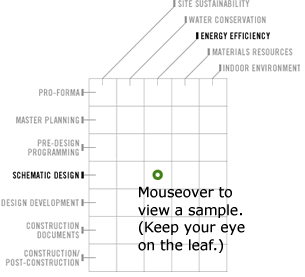

Behold the Green Matrix
Ratcliff architects develop and share sustainable
design tool

by Tracy Ostroff
It’s been a couple of years since Dan Meza, AIA, a project architect at Ratcliff in Emeryville, Calif., and some of his colleagues gathered to start a green resources committee—and they have been busy ever since. In that time, the committee “pooled their enthusiasm as well as their resources” to devise a learning tool they call the Green Matrix. The matrix started as a grid on 11x17 paper, then morphed into a PDF document on CD-ROM, and is now a three-dimensional, Web-based application that provides an extensive guide for designers who seek ways to implement green design into their projects.
 “We
thought we had to make this really easy, step-by-step, for a designer
to implement. If we dump every possible strategy on someone, they’re
not going to want to do it. But if we put it into bite-size pieces, then
it gets more easily digested” says Meza, a matrix coauthor.
“We
thought we had to make this really easy, step-by-step, for a designer
to implement. If we dump every possible strategy on someone, they’re
not going to want to do it. But if we put it into bite-size pieces, then
it gets more easily digested” says Meza, a matrix coauthor.
The group started to classify strategies by five standard green topics, which happened to follow the LEED™ program: site sustainability, water conservation, energy efficiency, materials resources, and indoor environment. “Then we thought we could cross-reference it again, chronologically, and we would make it even more manageable. So we overlaid the idea of design process, using the standard AIA phases: pro-forma, master planning, predesign, schematic design, design development, construction documents, and construction/post occupancy,” Meza explains.
 When
they finished this exercise, they had hundreds of pieces of paper. They
made summaries, created the 11x17 matrix, and filled in the squares. The
staff applauded their efforts and pinned the grids up at their desks and
work stations. “It brought green design home because it became more
of our regular design process,” says Meza. “When a client
or an engineer asks about promoting a green strategy at a given time,
there’s a place to see what might be appropriate.”
When
they finished this exercise, they had hundreds of pieces of paper. They
made summaries, created the 11x17 matrix, and filled in the squares. The
staff applauded their efforts and pinned the grids up at their desks and
work stations. “It brought green design home because it became more
of our regular design process,” says Meza. “When a client
or an engineer asks about promoting a green strategy at a given time,
there’s a place to see what might be appropriate.”
At first, Meza says, it was difficult for the younger staff to sell their idea in the context of the firm’s more established design process. But they found an advocate in Christopher Ratcliff, AIA, the firm’s principal and CEO. “As humans we’re going to have to redesign our footprint completely to stick around on earth. When you really begin to accept that deeply, it’s very exciting when you see some young designers get turned on to doing something that is another step in that direction,” Ratcliff says. “You can’t go back.”
Adding another dimension
“People would say ‘that’s great—a green-roof strategy
should be done at this crossroad, but I don’t know where to go for
that information. We then realized we were going to have to make the matrix
a source of information as well,” Meza continues. The group then
developed a CD-ROM version, a PDF document on which the designer could
click on a particular square or intersection taking him or her to a synopsis
or strategy and further resources, including Web sites, books, and articles.
Once they “let it out of the bag, outside our office” that they were developing the CD-ROM version of the Green Matrix tool, the “interest level grew exponentially.” The firm ran about 2,500 copies, and within nine months or so they were all snapped up, Meza reports. As interest grew, Meza explains, they realized they would need to be able to add and update information quickly. They also had clients hankering for a more interactive application. For that enhancement, they spent six months developing a Web site, which culminated in the Green Matrix’s public opening and presentation at the EnvironDesign 8 Conference last month.
Business plans
Ratcliff has come a long way from the 11x17 pin-up. Meza reports that
the feedback section on the Web site allows users to ask specific questions
and gives the firm a window into “what’s new and happening
in the green world out there.”
Meza says the Green Matrix is a public service, not-for-profit endeavor by the firm. “It was really to help our own firm. Then the light came on for us that there’s a lot of people who know a lot of things, and we could tap that market if we provide a platform for people to come and share ideas.” The Green Matrix evolved from several principles. Meza says they wanted to make it an open forum where architects and others would be able to share ideas. “We felt that there are a handful of great green designers, but everyone wants to get involved, and we wanted to share those experiences with people who lack them.” They also wanted experienced architects to share their feedback and to create an unbiased forum for the dialogue. The site does not take advertising.
One of the next steps is to develop a business plan for the Green Matrix. “The reality, unfortunately, is that we can’t do this free forever.” Meza notes that people have mentioned that it is a timesaver that allows them focus, saving them from blind Web searches. “If you’re saving time for someone, then you’re saving them money.” The five years they have spent on the project have been extracurricular. “We still would intend for it to be a not-for-profit tool and would just want it to be able to break even on the time and material spent.” They may look into a subscription service or cooperative venture.
Meza says they use the U.S. Green Building Council as a resource in many of the green strategies they offer on the matrix, but, as of now, they do not show how a particular strategy is equivalent to a particular LEED point for the USGBC-rating system. They hope to add that link soon. “It’s so obvious now that designers, engineers, and even owners are so interested [in LEED] that we have to address it and keep it easy for them to make the connection,” he acknowledges.
What’s next?
In addition to developing a business plan, Meza says they would like to
offer a “green strategy template,” a spreadsheet from which
you select strategies, much like adding products to a shopping cart in
a retail Web site. “When you add that you will get a worksheet that
will give you a summary of the strategy, plus it will give you the relevant
LEED credit, rules of thumb, and best practices. We hope to be able set
up accounts so users can look at what they’ve done in the past so
they can see what’s worked. We’re also hoping that if we can
keep it public and keep clients anonymous, that information will be shared
among users as well.
They are also developing a summary button, “so if you wanted to just cut to the chase and find out the cost information,” the Green Matrix could provide that in a conceptual manner, Meza says. They are not planning to embed a calculator, but they will provide links to other Web sites that provide price indices for similar situations or life-cycle cost analysis.
Of Ratcliff, Meza says, “We’ve been around for a 100 years in the Bay Area, so we have longstanding clients. And we’ve been known for great, solid design. We have not always been known as a cutting-edge green firm. Not that designing the matrix does that for us, but it’s the change of the design culture here in the office that we want to be experts in this as we are experts in so many other things that we do. I think we are going to attract a new kind of client. It gives us a more well-rounded qualification, and they can feel more confident that we have the abilities to do it because we have this basic tool that can walk us through the steps from the beginning to the end of a project.”
Copyright 2004 The American Institute of Architects.
All rights reserved. Home Page ![]()
![]()
 |
||
| Visit the
Green Matrix Web site. To see what the AIA Committee on the Environment is doing, visit
their
|
||